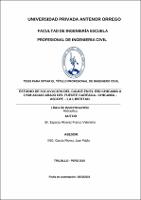Mostrar el registro sencillo del ítem
Estudio de socavación del cauce en el río Chicama a 2 km aguas abajo del puente carega - Chicama - ascope - la libertad
| dc.contributor.advisor | García Rivera, Juan Pablo | |
| dc.contributor.author | Esparza Alvarez, Franco Valentino | |
| dc.creator | Esparza Alvarez, Franco Valentino | |
| dc.date.accessioned | 2019-11-20T17:25:39Z | |
| dc.date.available | 2019-11-20T17:25:39Z | |
| dc.date.issued | 2019 | |
| dc.identifier.uri | https://hdl.handle.net/20.500.12759/5644 | |
| dc.description.abstract | En el presente trabajo de investigación se realiza el modelamiento unidimensional en el software HEC-RAS 5.0.3 y bidimensional utilizando también software HEC-RAS en este caso en su versión 5.0.7, del cauce del rio Chicama tomando como referencia el puente Careaga en una extensión de 2 km( 300 m aguas arriba de dicho puente y 1700 m aguas abajo) , para esto se tendrá que analizar los datos topográficos del tramo a estudiar los cuales fueron tomados por un drone y GPS diferencial, se analizó la data histórica de los caudales de ese sector de donde se extrajo 5 caudales los cuales son los representativos, estos caudales se usaran para conformar los 5 perfiles de flujo para el modelo unidimensional y un hidrograma para el modelo bidimensional. En el modelo unidimensional el análisis demostró que las velocidades máximas se encuentran en las secciones que se encuentran entre los puentes además de la zona adyacente a la cantera que sus velocidades son muy elevadas por lo que en el perfil de flujo más desfavorable que es el PF5 con un caudal de 1500 m3/s las velocidades son de 3.07m/s y 4.66 m/s respectivamente. En el modelo bidimensional el análisis demostró que las velocidades son más precisas puesto que podemos observar de cualquier punto del modelo y no estamos limitados a secciones como lo fue en el modelo unidimensional, en el modelo bidimensional corroboramos que las velocidades máximas se encuentran entre los puentes, para ser más exactos entre los pilares del puente además de las zona adyacente a la cantera, las velocidades son 4.705 m/s y 4.839 m/s respectivamente. La colocación de un dique en el margen derecho del río Chicama, aguas abajo puente Careaga beneficia positivamente a la zona puesto que ya no presenta inundación en ese margen del rio. En el modelamiento se pudo observar que los valores son más elevados en el análisis bidimensional, estos valores son más precisos puesto que en este modelamiento el comportamiento del agua se da en dos direcciones siendo un análisis más real. | es_PE |
| dc.description.abstract | In this research work, one-dimensional modeling is performed in the HEC-RAS 5.0.3 and two-dimensional software, also using HEC-RAS software in this case in its version 5.0.7, of the Chicama riverbed, taking the Careaga bridge as a reference in an extension of 2 km (300 m upstream of said bridge and 1700 m downstream), for this we will have to analyze the topographic data of the section to be studied which were taken by a drone and differential GPS, the historical data of the flows of that sector from which 5 flows were extracted which are representative, these flows will be used to form the 5 flow profiles for the one-dimensional model and a hydrogram for the two-dimensional model. In the one-dimensional model, the analysis showed that the maximum speeds are in the sections that are between the bridges in addition to the area adjacent to the quarry that their speeds are very high, so in the most unfavorable flow profile that is the PF5 With a flow of 1500 m3 / s the speeds are 3.07m / s and 4.66 m / s respectively. In the two-dimensional model the analysis showed that the speeds are more precise since we can observe from any point of the model and we are not limited to sections as it was in the one-dimensional model, in the two-dimensional model we confirm that the maximum speeds are between the bridges, to be more exact between the bridge pillars in addition to the areas adjacent to the quarry, the speeds are 4,705 m / s and 4,839 m / s respectively. The placement of a dike on the right bank of the Chicama River, downstream Careaga Bridge benefits the area positively since it no longer presents flooding on that margin of the river. In the modeling it was observed that the values are higher in the two-dimensional analysis, these values are more precise since in this modeling the behavior of water occurs in two directions being a more real analysis | en_US |
| dc.description.uri | Tesis | es_PE |
| dc.format | application/pdf | es_PE |
| dc.language.iso | spa | es_PE |
| dc.publisher | Universidad Privada Antenor Orrego | es_PE |
| dc.relation.ispartofseries | T_ING.CIVIL_1793 | |
| dc.rights | info:eu-repo/semantics/openAccess | es_PE |
| dc.rights.uri | https://creativecommons.org/licenses/by/4.0/ | es_PE |
| dc.source | Universidad Privada Antenor Orrego | es_PE |
| dc.source | Repositorio Institucional - UPAO | es_PE |
| dc.subject | Modelamiento unidimensional | es_PE |
| dc.subject | Hidrograma | es_PE |
| dc.subject | Socavación | es_PE |
| dc.title | Estudio de socavación del cauce en el río Chicama a 2 km aguas abajo del puente carega - Chicama - ascope - la libertad | es_PE |
| dc.type | info:eu-repo/semantics/bachelorThesis | es_PE |
| thesis.degree.level | Título Profesional | es_PE |
| thesis.degree.grantor | Universidad Privada Antenor Orrego. Facultad de Ingeniería | es_PE |
| thesis.degree.name | Ingeniero Civil | es_PE |
| thesis.degree.discipline | Ingeniería Civil | es_PE |
| dc.subject.ocde | https://purl.org/pe-repo/ocde/ford#2.01.00 | |
| renati.type | https://purl.org/pe-repo/renati/type#tesis | |
| renati.level | https://purl.org/pe-repo/renati/level#tituloProfesional | |
| dc.publisher.country | PE | es_PE |
Ficheros en el ítem
Este ítem aparece en la(s) siguiente(s) colección(es)
-
Ingeniería Civil [1260]


